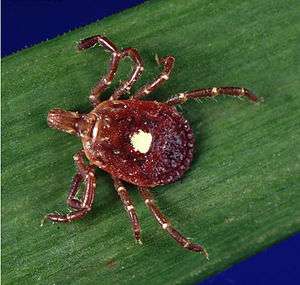Hydrachnidia
| Hydrachnidia | |
|---|---|
 | |
| Scientific classification | |
| Kingdom: | Animalia |
| Phylum: | Arthropoda |
| Class: | Arachnida |
| Subclass: | Acari |
| Order: | Trombidiformes |
| Suborder: | Prostigmata |
| (unranked): | Parasitengona |
| (unranked): | Hydrachnidia |
| Superfamilies[1] | |
| |
| Synonyms | |
| |
Hydrachnidia, also known as "water mites", Hydracarina or Hydrachnellae, are a group of mites covering more than 40 families and 5 000 species (Smith & Cook 1991) found in freshwater and marine habitats. As water mites of Africa, Asia, and South America have not been well-studied, the numbers are likely to be far greater. Other taxa of parasitengone mites include species with semi-aquatic habits, but only the Hydracarina are properly subaquatic. They exist in a variety of freshwater bodies, such as treeholes, hot springs, deep lakes and waterfalls, and some have adapted to marine environments. [2][1]
References
- 1 2 Di Sabatino, A., Gerecke, R., Martin, P. (2000). "The biology and ecology of lotic water mites (Hydrachnidia)". Freshwater Biology. 44 (1): 47–62. doi:10.1046/j.1365-2427.2000.00591.x.
- ↑ http://eol.org/pages/3020370/details
External links
- "Introduction to Hydrachnidia". Soil & Water Conservation Society of Metro Halifax. 2006. Retrieved 27 December 2012.
-
 Media related to Hydrachnidia at Wikimedia Commons
Media related to Hydrachnidia at Wikimedia Commons -
 Data related to Hydracarina at Wikispecies
Data related to Hydracarina at Wikispecies
This article is issued from Wikipedia - version of the 10/10/2016. The text is available under the Creative Commons Attribution/Share Alike but additional terms may apply for the media files.
